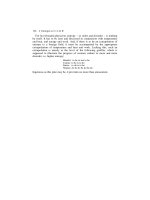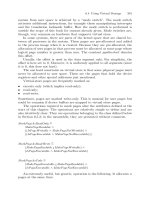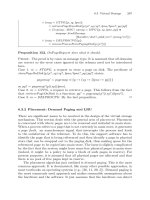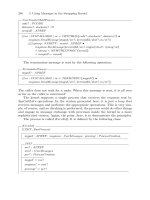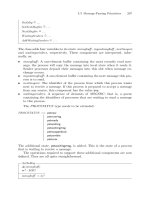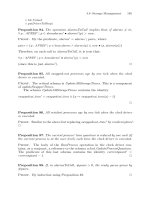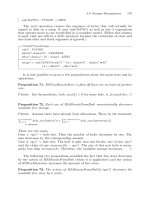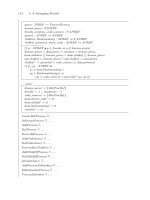Formal Models of Operating System Kernels phần 5 pps
Bạn đang xem bản rút gọn của tài liệu. Xem và tải ngay bản đầy đủ của tài liệu tại đây (294.15 KB, 31 trang )
4.6 Storage Management 185
∧ lck.Unlock
∧ putDriverToSleep)
Proposition 94. The operation alarmsToCall implies that, if alarms = ∅,
∀ p : APREF | p ∈ domalarms
• alarms
(p) > now.
Proof. By the predicate, alarms
= alarms \ pairs,where:
pairs = {p : APREF | p ∈ dom alarms ∧ alarms(p) ≤ now • (p, alarms(p))}
Therefore, on each call to alarmsToCall,itistruethat:
∀ p : APREF | p ∈ domalarms
• alarms
(p) > now
(since this is just alarms
). ✷
Proposition 95. All swapped-out processes age by one tick when the clock
driver is executed.
Proof. The critical schema is UpdateAllStorageTimes.Thisisacomponent
of updateSwapperTimes.
The schema UpdateAllStorageTimes contains the identity
swappedout time
= swappedout time ⊕{p → swappedout time(p) − 1}
✷
Proposition 96. All resident processes age by one tick when the clock driver
is executed.
Proof. Similar to the above but replacing swappedout
time
by residencytime
.
✷
Proposition 97. The current process’ time quantum is reduced by one unit (if
the current process is at the user level) each time the clock driver is executed.
Proof. The body of the RunProcess operation in the clock driver con-
tains, as a conjunct, a reference to the schema sched.UpdateProcessQuantum.
The predicate of this last schema contains the identity currentquant
=
currentquant − 1. ✷
Proposition 98. If, in alarmsToCall, #pairs > 0, the ready queue grows by
#pairs.
Proof. By induction using Proposition 49. ✷
186 4 A Swapping Kernel
Clock
Process
Swapper
Process
Alarms
etc.
Clock
ISR
Signal
Fig. 4.3. Interaction between clock and swapper processes.
4.6.4 Process Swapping
In this kernel, user processes are swapped in and out of main store. This
mechanism is introduced so that there can be more processes in the system
than main store could support. It is a simple storage-management principle
that pre-dates virtual store and requires less hardware support. In our scheme,
processes are swapped after they have been resident in main store for a given
amount of time. When a process is swapped, its entire image is copied to disk,
thus freeing a region of main store for another user process to be swapped in.
The relationship between this process, the Swapper process, and the clock
process is depicted in Figure 4.3
Swapping is performed by two main processes: one to select victims and
another to copy process images to and from a swapping disk.
The swapper process is modelled by the following class. The main routine
is RunProcess.
SwapperProcess
(INIT , swapProcessOut, swapCandidateOut, swapProcessIn,
swapProcessIntoStore, DoDiskSwap, RunProcess)
donesema : Semaphore;
swapsema : Semaphore;
pdescrs : ProcessStorageDescrs;
proctab : ProcessTable;
sched : LowLevelScheduler;
sms : SharedMainStore;
hw : HardwareRegisters;
diskrqbuff : SwapRQBuffer;
realmem : SharedMainStore
4.6 Storage Management 187
INIT
dsma?:Semaphore
pdescs?:ProcessStorageDescrs
sched?:LowLevelScheduler
pt?:ProcessTable
store?:SharedMainStore
hwr?:HardwareRegisters
dskrq?:SwapRQBuffer
swpsema?:Semaphore
ms?:SharedMainStore
donesema
= dsma?
swapsema
= swpsema?
pdescrs
= pdescr?
sched
= sched?
proctab
= pt?
sms
= store?
hw
= hwr?
diskrqbuff
= dskrq?
realmem
= ms?
requestWriteoutSegment =
requestReadinSegment =
swapProcessOut
=
swapCandidateOut =
swapProcessIn =
swapProcessIntoStore =
doDiskSwap =
waitForNextSwap =
RunProcess =
The following operation requests that a segment of main store be written
to disk. It supplies the start and end addresses of the segment to be copied:
requestWriteoutSegment
p?:APREF
start?, end?:ADDRESS
(∃ rq : SWAPRQMSG •
rq = SWAPOUT p?, start?, end?
∧ diskrqbuff .SetRequest[rq/rq ?])
188 4 A Swapping Kernel
The next operation models the operation to read a segment into main
store. The name of the process to which the image belongs, as well as the
address at which to start copying, are supplied as parameters. The disk image
contains the length of the segment.
requestReadinSegment
p?:APREF
loadpoint?:ADDRESS
(∃ rq : SWAPRQMSG •
rq = SWAPIN p?, loadpoint?
∧ diskrqbuff .SetRequest[rq/rq ?])
The operation that actually swaps process images out is given by the
following schema. The operation, like many of those that follow, is deceptively
simple when written in this form. It should be noted that it is disk residency
time that determines when swapping occurs; the basic principle on which the
swapper operates is that processes compete for main store, not disk residency.
swapProcessOut =
(∃ pd : ProcessDescr •
proctab.DescrOfProc[p?/pid?, pd /pd !]
∧ requestWriteoutSegment
∧ sched.MakeUnready[p?/pid?]
∧ realmem .FreeMainStore
∧ pdescr.ClearProcessResidencyTime
∧ pdescr.SetProcessStartSwappedOutTime
∧ pdescr.BlockProcessChildren
∧ pd .SetStatusToSwappedOut
∧ pdescr.MarkAsSwappedOut)
A high-level description is relatively easy. The process descriptor of the pro-
cess to be swapped out is retrieved from the process table. The segment cor-
responding to the selected process is determined (and copied) and the process
is unreadied. The residency and start of swapout times for the process are
then cleared and the children of the selected process are then blocked. The
status of the selected process is set to swappedout.
Processes have to be swapped into store. This operation is defined as:
swapCandidateOut =
(∃ pd : ProcessDescr •
proctab.DescrOfProcess[p?/pid?, pd /pd !]
∧ (proctab.ProcessHasChildren
∧ ((proctab.IsCodeOwner
∧ swapProcessOut
∧ proctab.BlockProcessChildren )
∨ swapProcessOut))
4.6 Storage Management 189
∨ ((proctab.IsCodeOwner ∧ swapProcessOut)
∨ swapProcessOut))
When a process is to be swapped into main store, the following operation
is employed. It determines whether the process has any child processes. If
it has, it swaps the process into store and readies its children. If the newly
swapped-in process owns the code it executes, it marks its code as in store and
then performs the swap-in operation. If the process has no children, there is
no need to ready them; the rest of the operation is the same as just described.
swapProcessIn =
(proctab.ProcessHasChildren
∧ ((proctab.IsCodeOwner
∧ swapProcessIntoStore
∧ pdescr.ReadyProcessChildren)
∨ (pdescr.CodeOwnerSwappedIn ∧ swapProcessIntoStore)))
∨ ((proctab.IsCodeOwner ∧ swapProcessIntoStore)
∨ pdescr.CodeOwnerSwappedIn)
∧ swapProcessIntoStore
The following operation performs the swap-in operation. It allocates store
and reads in the process image. It then updates the storage descriptors as-
sociated with the newly swapped-in process and then updates the relocation
registers so that the image can be accessed correctly at its new address. The
process is marked as in store and its status set to pstready; the swap param-
eters are then updated. Finally, the newly swapped-in process is readied and
a reschedule occurs.
swapProcessIntoStore =
(sms.AllocateFromHole[mspec/mspec!]
∧ ([mspec : MEMDESC ; ldpt : N; sz : N |
∧ ldpt = memstart(mspec)
∧ sz = memsize(mspec)]
∧ requestReadinSegment[ldpt/loadpoint?]
∧ donesema.Wait
∧ pdescrs.UpdateProcessStoreInfo[sz/sz ?, mspec/mdesc?])
\{ldpt, sz, mspec}
∧ hw.UpdateRelocationRegisters
∧ pdescrs.MarkAsInStore
∧ pd .SetStatusToReady[p?/pid?]
∧ pdescrs.SetProcessStartResidencyTime
∧ pdescrs.ClearSwappedOutTime
∧ (sched.MakeReady[p?/pid?]
o
9
sched.ScheduleNext)
The doDiskSwap operation is the main swapper routine. It determines the
process to swap in and then finds out whether it can allocate its image in free
190 4 A Swapping Kernel
store. If it can, it just performs the swap. If not, it determines whether it can
swap some process out of store—that process should have an image size that
is at least as big as that of the process to be swapped in. Once that candidate
has been found, the image size is determined and the swap-out operation is
performed; when the victim has been swapped out, the disk process is swapped
into store.
doDiskSwap =
(pdescrs.NextProcessToSwapIn[p?/pid!, rqsz ?/sz!]
∧ (sms.CanAllocateInStore ∧ swapProcessIntoStore)
∨ (pdescrs.HaveSwapoutCandidate
∧ (pdescrs.FindSwapoutCandidate[outcand/cand !, mspec/slot!]
∧ [mspec : MEMDESC ; start, end : ADDRESS ; sz : N |
start = memstart(mspec) ∧ sz = memsize(mspec)
∧ end =(start + sz ) − 1]
∧ (swapCandidateOut[outcand/p?, start/start?,
end/
end?
, sz/sz ?]
o
9
swapProcessIn))) \ {outcand, start, end, sz, mspec})
\{p?, rqsz ?}
As can be seen, this swapper is based upon disk residency time to determine
whether swapping should occur. Clearly, if there are no processes on disk,
no swapping will occur; only when there are more processes than can be
simultaneously maintained in main store does swapping begin. This seems
a reasonable way of arranging matters: when there is nothing to swap, the
swapper does nothing.
waitForNextSwap = swapsema.Wait
RunProcess
=
WaitForNextSwap
o
9
(∀ i :1 ∞•
doDiskSwap
o
9
waitForNextSwap)
Proposition 99. If the owner of a process’ code is swapped out, that process
cannot proceed.
Proof. By Proposition 54, since MakeUnready removes the process from the
ready queue and alters its state to pstwaiting. ✷
Proposition 100. When a parent process is swapped out, all of its children
are blocked.
Proof. This is an immediate consequence of the BlockProcessChildren
propositions. ✷
The final organisation of this subsystem is shown in Figure 4.4.
4.7 Process Creation and Termination 191
Clock
Process
Disk
Handler
Swap
Disk
Process
Swapper
Process
Dezombifier
ISR
ISR
Fig. 4.4. Interaction between clock, swap and dezombifier processes.
4.7 Process Creation and Termination
A major issue to be addressed is the following: how are processes created
within a system such as this? The answer is that some processes are created
at boot time, others when the system is running. Among the latter class are
user processes. In this section, mechanisms are defined for creating system
and user processes. System processes come in two varieties, so two operations
are defined for their creation.
Most system processes never terminate but user processes do, so a primi-
tive is defined to release resources when a user process ends; resource release
includes the handling of zombies. For all of the system processes defined in
this chapter, termination is an exceptional behaviour.
The operations required to create processes (of all kinds) and to handle
the termination of user processes are all collected in the following class.
ProcessCreation
(INIT ,
CreateUserProcess,
CreateChildUserProcess,
CreateSystemProcess,
CreateDeviceProcess ,
TerminateProcess)
192 4 A Swapping Kernel
proctab : ProcessTable
pdescrs : ProcessStorageDescrs
diskrqbuff : SwapRQBuff
realstore : REALMAINSTORE
lck : Lock
INIT
ptab?:ProcessTable
dskbf ?:SwapRQBuff
pdescr?:ProcessStorageDescrs
store?:REALMAINSTORE
lk?:Lock
proctab
= ptab?
diskrqbuff
= dskbf ?
pdescrs
= pdescr?
realstore
= store?
lck
= lk?
createNewPDescr
createAUserProcess
CreateUserProcess
CreateChildUserProcess
CreateSystemProcess
CreateDeviceProcess
writeImageToDisk =
deleteProcessFromDisk =
freeProcessStore
=
deleteSKProcess =
TerminateProcess =
The first operation to define creates a new process descriptor and adds it
to the process table. In order to define this operation, the following functions
are required:
mkpstack : N
1
→ PSTACK
mpdata : N
1
→ PDATA
These functions are intended to simulate the allocation of storage for the
classes of structure. A refined specification would fill in these details—for the
present, the axiomatic definitions will suffice.
The CreateNewPDescr operation just creates a new process descriptor.
It is supplied with the basic information required to create one through its
4.7 Process Creation and Termination 193
arguments. The predicate creates descriptors for the new process’ stack and
data areas (using the above-declared functions). The identifier of the new
process is also supplied as an argument. The schema is somewhat uninteresting
from the operating systems viewpoint; however, it does show how an Object-Z
entity is dynamically created.
The operation CreateNewPDescr is, therefore, as follows:
createNewPDescr
pid?:APREF
kind?:PROCESSKIND
prio?:SCHDLVL
timequant?:TIME
stacksize?, datasize?:N
code ?:PCODE
mspec?:MEMDESC
rqsz ?:N
∃ pd : ProcessDescr ; stat : PROCSTATUS; stk : PSTACK; data : PDATA •
stat = pstnew
∧ stk = mkpstack (stacksize?)
∧ data = mkpdata(datasize?)
pd .Init[stat/stat?, kind?/knd ?, prio/slev ?, timequant?/tq?,
stk/pstack?, data/pdata?, mspec?/mem?, rqsz ?/msz ?]
∧ proctab.AddProcessToTable[pd /pd ?]
(The AddProcessToTable operation requires no substitution because it expects
the process to be identified by a variable pid?.)
The user-process creation operation proper is as follows. It creates a pro-
cess descriptor for the new process, thus enabling it to be represented within
the system. As part of this, a test (proctab.CanGenPId)ismadeastowhether
the system has reached its maximum number of processes. The schema is com-
plicated by the fact that allocation might have to take place on disk and not in
main store. It should be noted that the identifier of the newly created process
is returned by this operation; this will be of some importance, as will be seen.
createAUserProcess
code ?:PCODE
stacksize?, datasize?:N
prio?:SCHDLVL
timequant?:TIME
newpid!:APREF
∃ p : APREF ; rqsz : N; prio : SCHDLVL;
mspec : MEMDESC ; kind : PROCESSKIND; qimage : MEM |
kind = ptuserproc ∧ prio = userqueue •
proctab.CanGenPId ∧ (proctab.NewPId[p/p!] ∧ p = newpid!
194 4 A Swapping Kernel
∧ rqsz =#code ?+stacksize?+datasize?
∧ ((realstore.RSCanAllocateInStore[rqsz /rqsz ?]
∧ realstore.RSAllocateFromHole[rqsz /rqsz ?, mspec/mspec!]
∧ createNewPDesc[rqsz /rqsz ?, mspec/mspec?]
∧ pdescrs.MakeInStoreProcessSwappable[p/pid?])
∨ (∧ mspec = mkmspec(0, rqsz )
∧ createNewPDesc[rqsz /rqsz ?, mspec/mspec?]
∧ realstore.CreateProcessImage[stacksize?/stksz ?,
datasize?/datasz ?, image/image!]
∧ writeImageToDisk[p/pid?, image/image?]
∧ pdescrs.MakeProcessOnDiskSwappable[p/pid?]))
∧ pdescrs.AddProcessStoreInfo[p/p?, mspec/mdesc?, rqsz /sz ?])
If there are no free process identifiers and CanGenPId fails, an error should
be raised. However, for the purposes of clarity, errors are ignored in this book.
The case should be noted, however.
In a similar fashion, a creation operation for system and device processes
needs to be defined. There are some differences between it and the user-
process creation operation. In particular, all system-process identifiers and
storage areas can be predefined, so they can be supplied as configuration-time
or boot-time parameters. The schema defining the operation is as follows:
createASystemProcess
kind?:PROCESSKIND
pid?:APREF
code ?:PCODE
stacksize?, datasize?:N
prio?:SCHDLVL
mspec?:MEMDESC
∃ rqsz : N; tquant : TIME |
tquant = ∞∧rqsz =#code ?+stacksize?+datasize? •
realstore.RSAllocateInSTore[rqsz /rqsz ?]
∧ createNewPDEsc[rqsz /rqsz ?, tquant/timequant?]
There should be no errors raised by calls to this operation.
The following operation writes a new process image to disk. It will be
loaded into main store by the swapper at some later stage. This is the opera-
tion used above in the definition of the createAUserProcess schema.
writeImageToDisk
pid?:APREF
image?:MEM
(∃ rq : SWAPRQMSG •
rq = NEWSPROC pid?, image? ∧ diskrqbuff .Write[rq /rq ?])
4.7 Process Creation and Termination 195
It is now possible to continue with the definition of the interface operations
for the creation of all three kinds of process. The first operation is the one
that creates user processes. This differs from the other two schemata in that
it requires locking and that it returns a new process identifier.
CreateUserProcess =
∃ pprio : PRIO; tquant : TIME |
pprio = userqueue ∧ tquant = minpquantum •
lck.Lock
o
9
(createAUserProcess[pprio/prio?, tquant/timequant?]
o
9
lck.Unlock)
The lock is required because:
• This is an operation that is called when other processes are executing.
• This is an operation that is intended to be called from user processes.
So, it is reasonable to ask, how are processes actually created? In particular,
how is the first user process created? Without an initial user process, a process
outside the kernel that can call this primitive, how are user processes created?
The answer is simple: there is a kernel call that creates the initial user process.
The initial process is called the UrProcess andiscreatedwhenthekernel
finishes its initialisation. What is required is, then, the following:
CreateUrProcess =
∃ pprio : PRIO; tquant : TIME |
pprio = userqueue ∧ tquant = minpquantum •
createAUserProcess[pprio/prio?, tquant/timequant?]
This operation requires stack and data region sizes to be created: they will
be zero or very small. They are not specified because the UrProcess might
be used for purposes other than simply creating user processes (e.g., it could
count them, exchange messages with them, and so on). For this reason, the
storage areas are not specified by the existential. The operation also returns a
new process identifier (element of APREF ): it can be stored within the kernel
or just ignored.
Child processes are created by the operation that is defined next. It should
be noted that the basic operation is still createAUserProcess.
CreateChildUserProcess =
(∃ pprio : PRIO; tquant : TIME |
pprio = userqueue ∧ tquant = minpquantum •
lck.Lock
o
9
(createAUserProcess[pprio/prio?, tquant/timequant?]
∧ proctab.AddChildOfProcess[rqprocid ?/parent?, newpid!/child?])
o
9
lck.Unlock)
Now come the two operations to create the two kinds of system processes.
Both operations are based on the createASystemProcess operation. This op-
eration performs the same role in the creation of system and device processes
as createAUserProcess does in the creation of user processes.
196 4 A Swapping Kernel
A difference between the two following operations and the ones for user
processes is that the priorities are different. System and device processes each
have their own priority level. They are assigned the appropriate priority by
the creation operation.
First, there is the system-process creation operation:
CreateSystemProcess =
(∃ kind : PROCESSKIND; prio : SCHDLVL |
kind = ptsysproc ∧ prio = sysprocqueue •
createASystemProcess[kind /kind?, prio/prio?])
Next, there is the operation to create device processes:
CreateDriverProcess =
(∃ kind : PROCESSKIND; prio : SCHDLVL |
kind = ptsysproc ∧ prio = sysprocqueue •
createASystemProcess[kind /kind?, prio/prio?])
The storage areas are defined by the kernel-configuration operation, and the
code is statically defined as part of the kernel code. The following operations
are for use when processes terminate. In the present kernel, user processes
are the only ones that can terminate; all the other processes must continue
running until the system shuts down.
As noted above, the identifier of the process is also statically allocated.
This allows, inter alia, the identifiers to be hard-coded into all communica-
tions. (This will be of great convenience when IPC is defined in terms of
messages, as they are in the next chapter, where a full interface to the entire
kernel is defined.)
Next, it is necessary to handle process termination. Processes cannot sim-
ply be left to terminate. The resources belonging to a terminating process
must be released in an orderly fashion. For this kernel, as it stands, processes
can only hold storage as a resource, so this must be released before the process
descriptor representing the process is deleted. In addition to releasing store,
a process might have unterminated children and must, therefore, become a
zombie before it can be killed off completely. The following operations imple-
ment the basics (and add a few extra operations to give the reader an idea of
some of the other things that might need to be handled during termination).
If a process is on disk when it is terminated (say, because of system ter-
mination or because of some error that we have not specified in this chapter),
its image must be erased. The operation whose schema follows performs that
operation.
deleteProcessFromDisk
p?:APREF
(∃ rq : SWAPRQMSG •
rq = DELSPROC p?
∧ diskrqbuff .Write[rq /rq ?])
4.7 Process Creation and Termination 197
When a process terminates, its storage must be freed. The following
schema defines what happens. It is really just an interface to FreeMainstore-
Block:
freeProcessStore
p?:APREF
descr?:MEMDESC
(∃ start : ADDRESS; sz : N |
start = memstart(descr?) ∧ sz = memsize(descr?) •
realstore.FreeMainstoreBlock[start/start?, sz/sz ?])
Finally, the full operation for releasing process storage is defined. The way
in which storage is released will, at some point, depend upon whether the ter-
minating process owns its code or shares it with some other process. Clearly, if
the process owns its code, the store for the code can just be deleted—provided,
that is, the process has only terminated children. The basic operation for re-
leasing storage is as follows. It should be noted that there will be some extra
work for handling zombie processes.
releaseProcessStorage =
deleteProcessFromDisk
∧ ((proctab.IsCodeOwner ∧ proctab.DelCodeOwner)
∨ (∃ owner : APREF •
proctab.DelCodeSharer[owner/owner?, p?/sharer?]))
∧ (∃ pd : ProcessDescr ; md : MEMDESC •
proctab.DescrOfProcess[p?/pid?, pd /pd !]
∧ pd .StoreDescr[md/descr !]
∧ freeProcessStore[md/descr?])
∧ pdescrs.RemoveProcessStoreInfo
System and device processes are easier to handle. Their storage can just be
deleted. In this system, there are no hierarchical relationships between system
and driver processes. The schema defining the operation that releases kernel
process storage is the following:
deleteSKProcess
=
releaseProcessStorage
∧ proctab.DelProcess[p?/pid?]
It can be argued that a system shutdown can be performed without freeing
the storage that system and device processes occupy. This is messy, so the
operation just defined frees the process’ space and then deletes its process
descriptor. This choice has the consequence that any process in this kernel
can execute the operation just defined when it terminates.
The operations just defined can be used to define the TerminateProcess
operation. This operation is defined below.
198 4 A Swapping Kernel
TerminateProcess
=
lck.Lock
o
9
((∃ pd : ProcessDescr •
proctab.DescrOfProcess[p?/pid?]
∧ (¬ proctab.ProcessHasChildren
∧ ((proctab.ProcessHasParent
∧ proctab.ParentOfProcess[parent/parent!]
∧ proctab.RemoveProcessFromParent
[parent/parent?, p?/child?]
∧ pd .SetStatusToTerminated
∧ deleteSKProcess)
\ {parent}
∨ (pd .SetStatusToTerminated
∧ deleteSKProcess))
∨ (proctab.ProcessHasChildren
∧ proctab.MakeZombieProcess[p?/pid?])))
∧ lck.Unlock)
The operation uses a lock instead of a semaphore because, strictly speaking,
it belongs to the layer implementing the process abstraction.
The termination operation also has to handle the case in which a par-
ent process terminates before any of its children do. If a parent terminates,
its storage will be deallocated but this will also remove its code from main
store. Without code, the children cannot execute, so a mechanism must be
implemented to prevent the parent’s code from being deleted. (If parents and
children share data storage, it, too, must be prevented from deallocation.) The
zombie mechanism whose operations were defined together with the process
table is used to do this.
Basically, when a parent process terminates, a check is made to see if there
are any active child processes. If there are no active children, the parent is
allowed to terminate normally. Otherwise, the parent is unreadied and placed
in a special waiting state (which we refer to, here, as the “zombie” state).
When all the children of a zombie parent have terminated, the parent can be
deallocated (properly terminated). The deallocation is the same as for normal
processes; each zombie must have a process descriptor, at least to record the
locations and sizes of its storage areas. The only problem is that children can
create children: in the model, this requires that the transitive closure of the
child relation be used to determine all the children of a parent process.
4.8 General Results
This final section contains the proof of a number of propositions that deal
with properties of the kernel.
The propositions stated and proved in this section are collected here for
convenience.
4.8 General Results 199
Proposition 101. When a process is swapped in, it enters the ready queue.
Proof. The predicate of schema swapProcessIn contains MakeReady[p?/pid?]
as a conjunct in an unconditional location. ✷
Proposition 102. When a parent process is swapped out, none of its children
appear in the ready queue.
Proof. By Proposition 89. ✷
Proposition 103. When a parent process is swapped in, its children change
state and appear in the ready queue.
Proof. The appropriate schema contains an instance of MakeReady. ✷
Proposition 104. When a device request is made, the current process enters
a waiting state and is no longer in the ready queue.
Proof. In this kernel, there is really only one good case upon which to
make an argument: clock alarms. When a process makes an alarm request,
has its context swapped out by the SVC ISR and its state is set to pstwaiting.
Furthermore, the ISR calls MakeUnready on the requesting process to remove
it from the scheduler. The process is held by the clock driver.
Device requests are made via SVCs, so the above will always hold. ✷
Proposition 105. When a device completes, the requesting process is re-
turned to the ready queue.
Proof. Again, the clock driver is the only example but it is normative.
When each process is awakened from its sleeping state (when its alarm clock
“rings”), MakeReady is called to return the process to the ready queue. The
MakeReady operation changes the status attribute in the process’ descriptor
to reflect the fact that it is ready (sets the status to pstready,thatis). ✷
Proposition 106. While a process is waiting for a device request to complete,
it is in neither the ready nor the running state. It is in the waiting state.
Proof. Proposition 104 states that the requesting process is unreadied by
the SVC ISR. Therefore, it cannot be in the ready state. The ISR also calls
the scheduler to execute another process, so the requesting process cannot be
executing. ✷
Proposition 107. Processes marked as zombie cannot be swapped out.
200 4 A Swapping Kernel
Proof. By the schema, FindSwapoutCandidate:
FindSwapoutCandidate
p?:APREF
cand !:APREF
rqsz ?:N
slot!:MEMDESC
(∃ p : APREF ; t : TIME | residencytime(p)=t •
p = p? ∧
pstatus(p) ∈ illegalswapstatus ∧
pkind(p) = ptsysproc ∧
pkind(p) = ptdevproc ∧
pmemsize(p) ≥ rqsz ? ∧
(∀ p
1
: APREF •
(p
1
= p ∧ p
1
= p?
∧ p
1
∈ dom residencytime ∧ t ≥ residencytime(p
1
))
⇒ p = cand ! ∧ pmem(p)=slot!))
Thecriticallineispstatus(p) ∈ illegalswapstatus,where:
illegalswapstatus = {pstrunning, pstwaiting, pstswappedout,
pstnew, pstterm, pstzombie}
Since this line appears as a conjunct, if it is false, it will invalidate the entire
predicate. ✷
Proposition 108. Processes marked as zombie cannot make device requests.
Proof. To make a device request, a process must be ready. Processes marked
as zombie are not active and are about to terminate. Therefore, they cannot
make any requests apart from those that release resources.
✷
Corollary 8. Processes marked as zombie cannot be present in device queues.
Proof. This follows from the immediately preceding proposition. ✷
Proposition 109. Each process is resident in at most one queue at any time.
Proof. The possible queues in which a process can reside are:
• one of the ready queue components;
• a device request queue (if appropriate);
• a semaphore queue; or
4.8 General Results 201
• the clock’s waiting sets.
In the definition of the semaphore Wait operation, there is an instance
of MakeUnready. This operation removes the caller from the ready queue.
Furthermore, the operation applies Enqueue to the caller to place it in the
local queue of processes waiting on the semaphore. Therefore, any process
performing a Wait operation cannot simultaneously be in a ready queue and
the semaphore’s queue of waiting processes.
When a process is ready, it is not waiting on the clock or a device or
semaphore (by definition). When a process is waiting on a device, it cannot
be marked as ready. ✷
Proposition 110. Each process is in exactly one state at any time.
This is the analogue of the informal property that a process is resident in
at most one queue at any time.
Proof. The state of each process (with the exception of the idle process,
which is a special case) is represented by its status attribute. Inspection of the
operations reveals that the value of this attribute is modified appropriately.
✷
Proposition 111. The scheduling r´egime employed by this kernel is fair.
Proof. The fairness property is interpreted as: no process waits infinitely
long before executing. Therefore, it must be shown that the scheduler does
not require processes to wait for infinite periods of time.
First, if there are only user-level processes, by Propositions 59 and 64, the
user-level queue implements a fair policy.
Clearly, by Proposition 62, all device processes execute as soon as possible.
Similarly, by Proposition 63, all system processes are executed before user-
level ones and after all device processes. Indeed, if there are no device processes
in the scheduler, system processes are executed in preference to user-level ones.
It can be observed that device and system processes are guaranteed by
design either:
• to terminate in a finite time; or
• to block after a relatively short period of execution.
Either way, device and system processes do not execute for infinite periods of
time before either terminating or blocking.
The next case to consider is that in which an infinite number of device pro-
cesses are executed on an infinite number of occasions between the execution
of user processes.
The clock process is driven by a periodic interrupt. The handler processes
are guaranteed to terminate promptly. However, the swapper processes might
202 4 A Swapping Kernel
have to wait for an infinite time because of a disk fault; when waiting, processes
are not in the scheduler’s ready queues.
To have a sufficient number of device processes in the scheduler, a user
process would have to make repeated requests. This implies that at least one
user process is executing infinitely often because device and system processes
do not usually make device requests (the swapper process can be discounted
because of its structure). However, user processes exhaust their time quantum
after a finite period of activity and are returned to the back of the user-level
ready queue, thus permitting rescheduling. If a process is waiting on a device,
it is not in the scheduler’s queues.
Finally, there is the case of infinite execution of the idle process. The idle
process is only executed when there are no other processes available in the
scheduler to execute. Therefore, if the idle process is executing and another
process becomes ready, the scheduler will block the idle process in favour of
the other process.
In the sense of fairness enunciated at the start, the scheduler is fair. ✷
Ich weiß nicht, was soll bedeuten,
Daß ich so traurig bin,
Ein M¨archen aus alten Zeiten,
Daß kommt mir nicht aus dem Sinn
– Heinrich Heine, Die Lorelei
3
A Simple Kernel
Scimus, et veniam petimusque damusque vicissim.
– Horace, Ars Poetica, 9
3.1 Intro duction
This chapter contains the first of the kernel models in this book. The kernel
modelled here is deliberately simple but is still useful. It is intended to be a
kernel for an embedded or small real-time system and to be a specification
of a workable system—one aim of the exercise is to produce a specification
that could be refined to working code. (As noted in Chapter 1, the kernels
in this book have been revised somewhat and are being refined to code as a
concurrent activity by the author.)
The model defined in this chapter is intended as an existence proof. It
is intended to show that it is possible to model an operating system kernel,
albeit a small one, using purely formal models. The model is simple, as is the
kernel—more extensive kernels will be modelled in the next two chapters, so
readers will find increasingly complex kernels that deal with some of the issues
left unresolved by the current one (for example, properties of semaphores in
the next chapter).
The current effort is also intended as an orienting exercise for the reader.
The style of the models is the same in this chapter as in the following ones.
As will be seen, there are structures that are common (at least in high-level
terms) and this chapter introduces them in their actual context.
This chapter uses Object-Z rather than Z.
3.2 Requirements
The operating system to be modelled in this chapter is intended to be suitable
for real-time processing, possibly in an embedded context. The kernel should
56 3 A Simple Kernel
be as small. The kernel should also be portable and, as such, there is no need
to specify any ISRs or the clock and associated driver and ISR. Devices and
the uses to which the clock is to be put are considered matters that depend
upon the particular instantiation of the kernel (e.g., some kernels might not
use drivers, or the clock might do more than just record the time and wake
sleeping processes).
The kernel must implement a priority-based scheduler. Initially, all prior-
ities are to be fixed. The priority of a process is defined before it is loaded
and assigned to it via a parameter; that parameter is to be used to set the
process’ priority in the scheduler.
The kernel is not to contain any storage-management modules. All storage
is to be allocated statically, offline, as part of the kernel configuration process.
The kernel is, basically, to implement the process abstraction, a scheduler
and IPC. The IPC is to be relatively rich and must include:
• semaphores (and shared memory);
• mailboxes and asynchronous messages.
All shared memory must be allocated statically when process storage is allo-
cated.
The kernel is to be statically linked with the user processes that run on it.
The memory map of the system is used to define where the various processes
reside and where the shared storage is. Primitives are to be provided to:
• create processes and enter them into the scheduler’s queue;
• terminate a process and release its process descriptor, together with any
semaphores and message queues that it owns.
There are operations, moreover, to perform the following operations:
• suspend a running process;
• create and dispose of IPC structures;
• perform IPC operations.
In addition, the kernel will support an operation that permits a process to
alter its priority.
3.3 Primary Types
This section contains the definitions of the basic types used by this model.
Processes must be referenced. The basic reference type is the following:
[PREF ]
As noted elsewhere, it is necessary to define constants to denote the null and
idle processes. The types are:
NullProcRef , IdleProcRef : PREF
3.3 Primary Types 57
Two more process reference types can now be defined. The first excludes the
null process reference, while the second excludes both the null and idle process
references:
IPREF == PREF \{NullProcRef }
APREF == IPREF \{IdleProcRef }
Without loss of generality, these types can be given a more concrete represen-
tation. First, it is necessary to define the maximum number of processes that
the kernel can contain:
maxprocs : N
(This is, in fact, the size of the process table or the number of process de-
scriptors in the table.)
Next, the types and values of the constants denoting the null and idle
processes are defined:
NullProcRef : PREF
IdleProcRef : IPREF
NullProcRef =0
IdleProcRef = maxprocs
They are defined so that they form the extrema of the IPREF type.
The PREF type can now be defined as:
PREF == NullProcRef IdleProcRef
The above definitions of IPREF and APREF still hold. For example, writing
constants out:
APREF == 1 maxprocs − 1
These definitions will, inter alia, make process identifier generation simpler
and easier to understand.
Each process is in one and exactly one state at any time during its exis-
tence. The following type defines the names of these states (the pst prefix just
denotes “processtable”):
PROCSTATUS ::= pstnew
| pstrunning
| pstready
| pstwaiting
| pstterm
The states can be understood as follows. When a process is newly created but
not added to the ready queue, it has state pstnew. When a process is ready to
58 3 A Simple Kernel
execute (is resident in the ready queue), it has state pstready. When a process
is executed, its state is pstrunning. Processes block or are suspended for a
variety of reasons (e.g., when they are waiting for a device). While a process
is waiting (for whatever reason), it is in state pstwaiting. Finally, when a
process terminates, it enters the pstterm state.
In this kernel, each process has a stack and code and data areas. The
process descriptor records the address and size of each of these areas. In
addition, the process descriptor records the pointer to the top of the stack.
The relevant types are defined as the following atomic types:
[PSTACK, PCODE, PDATA]
Of these, PSTACK is the only one that is used much in this model. It is
assumed that the process state consists partly of the state of its current stack
and that there is hardware support for the stack, so there is a stack register.
For the purposes of this model, it is assumed that values of type PSTACK
are atomic values that can be assigned to registers.
The other types, PCODE and PDATA, are only used in the current model
to represent values stored in each process’ process descriptor. If they were
expanded, they could be used for error checking; we ignore this possibility,
however.
Finally, the type representing process priorities is defined:
PRIO == Z
The interpretation is that the higher the priority, the greater the magnitude.
Therefore, the priorities −1, 20 and 0 are ordered (highest to lowest) as: −1,
0 and 20. There are no bounds placed on priorities, so it is always possible to
produce a priority that is lower than any other. In an implementation, there
would be a minimum priority equal to the greatest integer representable by
the hardware (2
32
− 1 on a 32-bit machine); conversely, the highest possible
priority would be the most negative integer representable by the hardware
(−2
32
on a 32-bit machine).
3.4 Basic Abstractions
This section is concerned with the definition of the basic constructs used to de-
fine the kernel. Three of these abstractions, ProcessQueue, HardwareRegisters
and Lock have appeared before, so they will be presented without comment.
The reader is warned again that the model in this chapter is written in Object-
Z and not in Z. For this reason, the constructs just listed are represented as
Object-Z classes and methods.
TheObject-ZversionoftheProcessQueue is modelled as follows. With
the exception of the constructs required for Object-Z, the model is exactly
the same as the Z version:
3.4 Basic Abstractions 59
ProcessQueue
(INIT , IsEmpty, Enqueue, RemoveFirst,
QueueFront, RemoveElement)
elts :iseqAPREF
INIT
elts
=
IsEmpty
elts =
Enqueue
∆(elts)
x?:APREF
elts
= elts
x?
RemoveFirst
∆(elts)
x!:APREF
x!=head elts
elts
= tail elts
QueueFront
x!:APREF
x!=head elts
RemoveElement
∆(elts)
x?:APREF
(∃ s
1
, s
2
:iseqAPREF •
s
1
x?
s
2
= elts
∧ s
1
s
2
= elts
)
The class exports the following operations, in addition to the initialisa-
tion (Init) operation: IsEmpty, Enqueue, RemoveFirst, QueueFront and Re-
moveElement.
In a similar fashion, the hardware register class is composed of operations
that are identical to those defined in the last chapter.
60 3 A Simple Kernel
HardwareRegisters
(SetGPRegs, GetGPRegs, GetStackReg, SetStackReg,
SetIntsOff , SetIntsOn, GetIP, SetIP
GetStatWd, SetStatWd)
hwgenregs : GENREGSET
hwstack : PSTACK
hwstatwd : STATUSWD
hwip : N
INIT
hwgenregs.INIT
hwstack
=0
hwstatwd
=0
S
hwip
=0
SetGPRegs
∆(hwgenregs)
regs ?:GENREGSET
hwgenregs
= regs ?
GetGPRegs
regs !:GENREGSET
regs !=hwgenregs
GetStackReg
stk!:PSTACK
stk = hwstack
SetStackReg
stk?:PSTACK
hwstack
= stk?
GetIP
ip!:N
ip!=hwip
SetIP
ip?:N
hwip
= ip?
3.4 Basic Abstractions 61
GetStatWd
stwd!:STATUSWD
hwstatwd
= stwd?
SetStatWd
stwd?:STATUSWD
stwd!=hwstatwd
SetIntsOff
intflg
= intoff
SetIntsOn
intflg
= inton
The lock class is as follows. It exports the Lock and Unlock operations,
as well as an initialisation operation. The class differs very slightly from the
specification of the previous chapter. In the Z specification, the operations
worked directly on the interrupt able/disable flag. Here, the class takes a ref-
erence to the hardware registers as its only initialisation parameter. The Lock
and Unlock operations are defined in terms of the reference to the hardware.
The net effect is that the Lock class must be instantiated before it is used.
Lock
(INIT , Lock , Unlock)
hw : HardwareRegisters
Assume that registers have been initialised.
INIT
hwrgs?:HardwareRegisters
hw
= hw?
Lock = hw.SetIntsOff
Unlock = hw.SetIntsOn
The lowest level of the kernel uses locking to ensure mutual exclusion.
Above this, semaphores are used. Semaphores are modelled by the following
class, which exports an initialisation operation (I
NIT ), Wait (P in Dijkstra’s
terminology) and Signal (V ). The class contains a process queue (waiters)
to hold its waiting processes; the waiters queue is unrelated to any other
